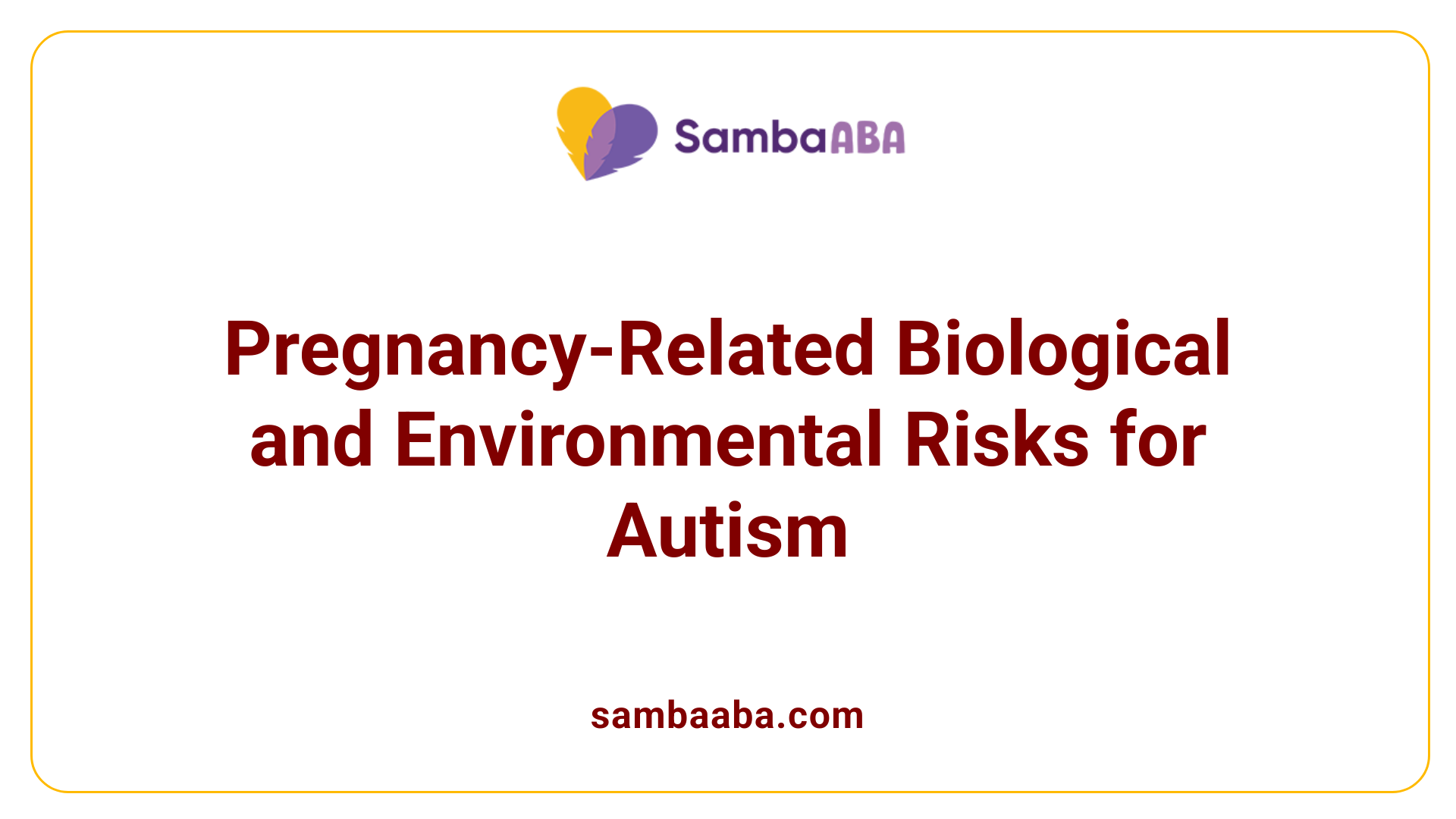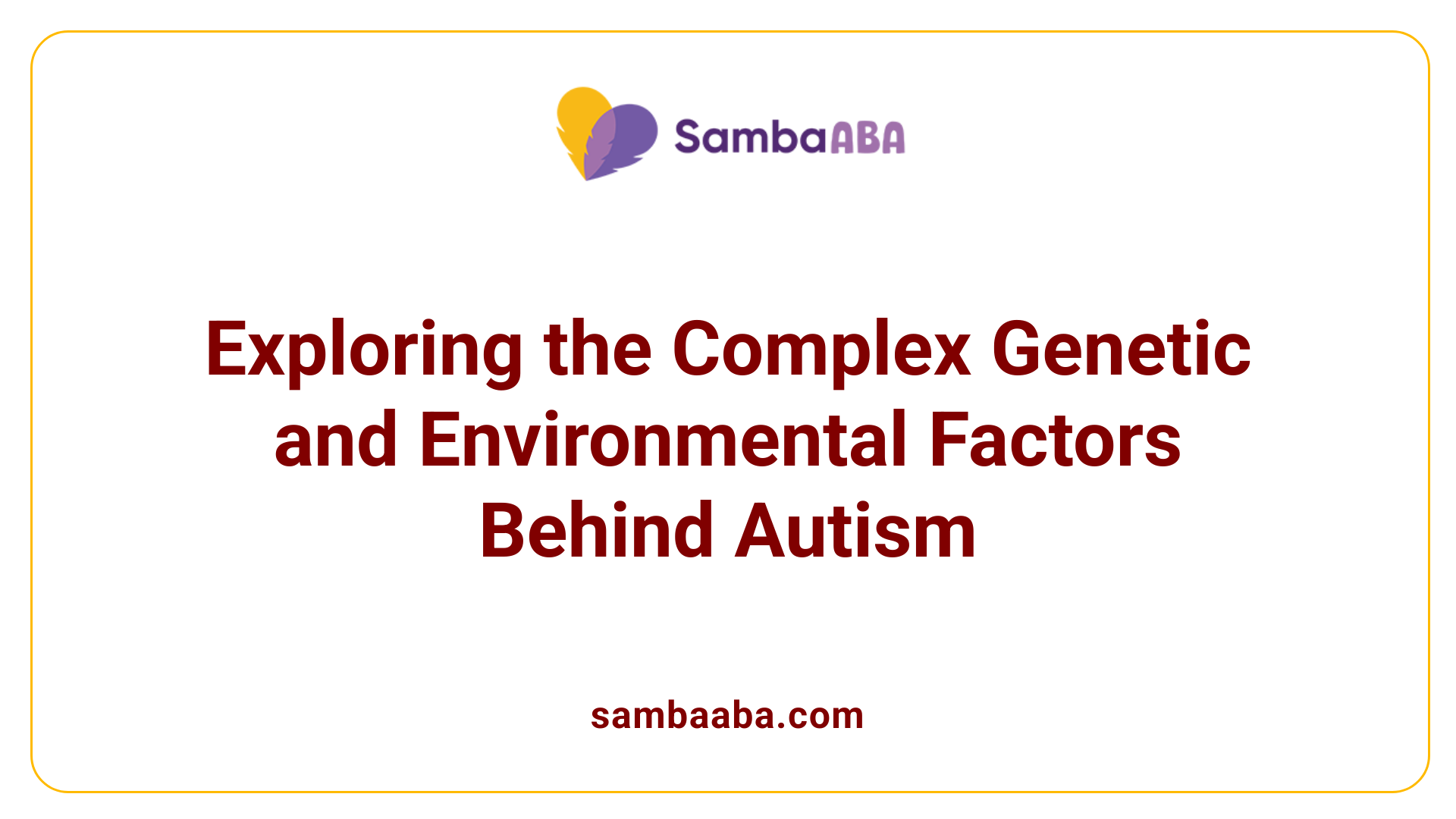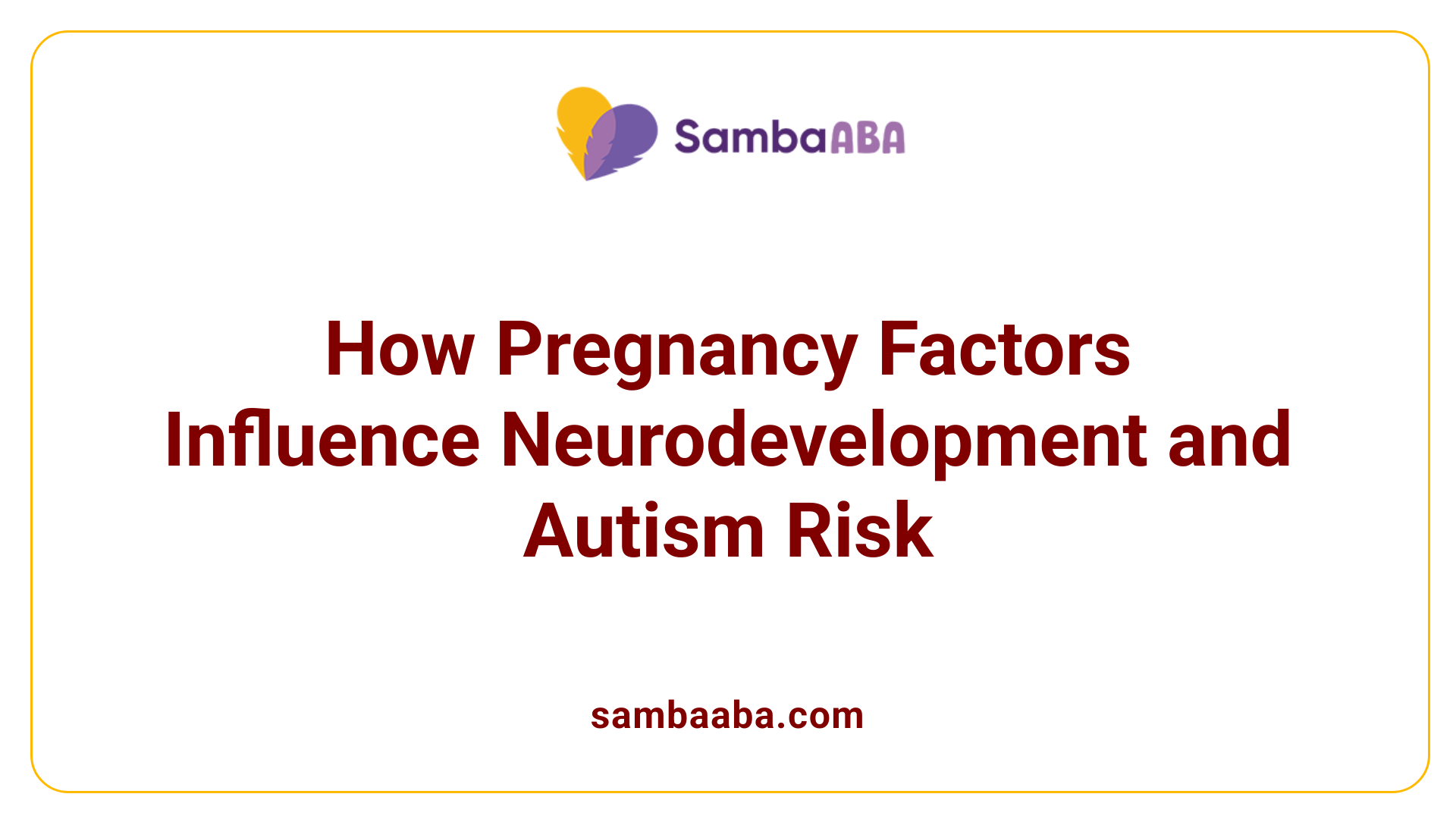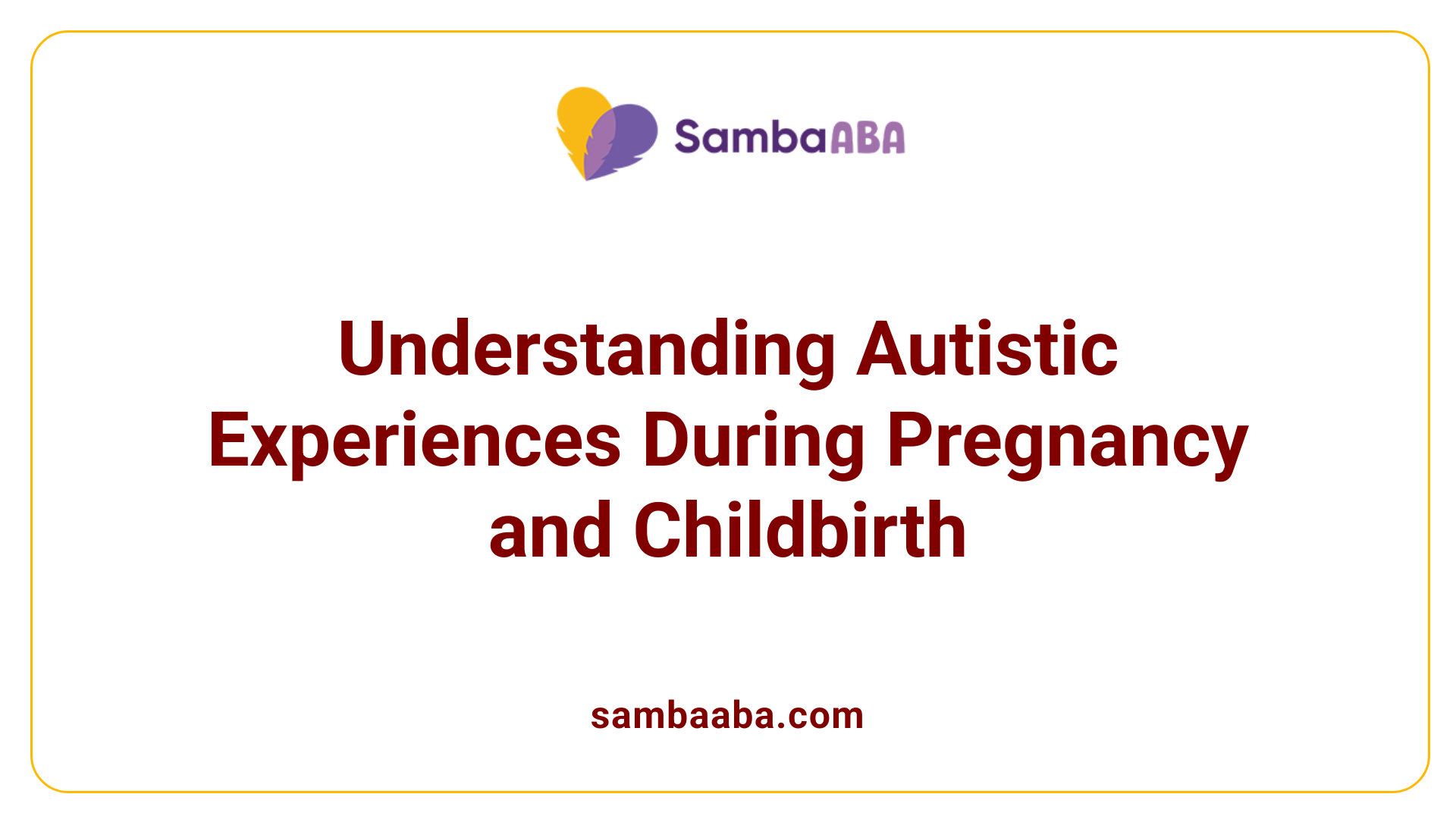Autism During Pregnancy
Unraveling the Complex Roots of Autism During Pregnancy
Understanding the multifaceted origins of autism spectrum disorder (ASD) in relation to pregnancy
Autism Spectrum Disorder (ASD) affects approximately 1 in 100 children worldwide, exhibiting a higher prevalence in males. The etiology of ASD is multifactorial, involving an intricate interplay between genetic, environmental, and neurodevelopmental influences. This article explores current scientific understanding of how pregnancy-related biological and environmental factors contribute to autism risk, highlighting key mechanisms, potential early indicators, and avenues for mitigation.
Biological and Environmental Risk Factors Influencing Autism During Pregnancy

What is the current scientific understanding of how pregnancy-related factors influence autism risk?
Current scientific understanding indicates that various pregnancy-related factors can influence the risk of autism spectrum disorder (ASD). Maternal health conditions such as gestational diabetes, obesity, and infections (viral and bacterial) are associated with increased ASD risk, likely through immune activation, inflammation, and hormonal disruptions that impact fetal brain development. Advanced parental age and perinatal factors like low birth weight, birth complications, and injury during labor also elevate risk, possibly due to genetic, environmental, and stress-related mechanisms.
Exposure to environmental toxicants, including air pollution, heavy metals, pesticides, and certain medications like SSRIs and valproic acid during pregnancy, can disrupt neurodevelopment through oxidative stress, mitochondrial dysfunction, and microbiome alterations. Overall, while many associations are supported by epidemiological and animal studies, further research is needed to clarify causal pathways and identify effective prevention strategies.
What are the biological and environmental risk factors during pregnancy that can influence autism development?
During pregnancy, several biological and environmental risk factors can influence the development of autism in offspring. Maternal health conditions such as diabetes—including gestational diabetes and maternal obesity—are strongly associated with increased risk, potentially due to hyperglycemia-induced oxidative stress and epigenetic changes in the fetus’s brain.
Exposure to environmental toxicants like pesticides, heavy metals, and certain chemicals has been linked to altered neurodevelopment, possibly through mechanisms involving gut microbiota and neuronal signaling pathways. Hormonal imbalances, such as prenatal exposure to synthetic hormones or hyperandrogenism, can affect neuroprotective pathways, increasing autism susceptibility, especially in males.
Additionally, factors like maternal fever, pregnancy complications like bleeding or birth asphyxia, advanced parental age, and stressful life events during pregnancy further elevate the risk of autism development.
How do maternal health factors like obesity and asthma impact the risk of autism?
Maternal health factors such as obesity, asthma, and diabetes have been associated with an increased risk of autism spectrum disorder (ASD) in offspring, potentially due to mechanisms like inflammation, hormonal imbalances, and epigenetic changes during pregnancy. Exposure to environmental toxins, including pesticides and heavy metals, as well as gestational hormonal conditions such as hyperandrogenism, may also contribute to autism risk through their effects on fetal neurodevelopment.
However, recent large-scale studies suggest that many of these associations are largely confounded by familial genetic and environmental factors, indicating that maternal health conditions themselves may not directly cause autism. Furthermore, paternal health conditions show similar links, supporting the idea that shared familial factors influence risk rather than direct causation.
Overall, while maternal health factors are associated with autism, current evidence emphasizes the importance of considering genetic and environmental confounders in understanding these relationships.
Are there prenatal indicators or early signs during pregnancy that might be linked to autism?
Prenatal indicators linked to an increased risk of autism include fetal anatomical anomalies detected via second-trimester ultrasound, such as differences in head, heart, or kidney structures, which have been associated with ASD severity. Additionally, genetic findings from chromosomal microarray analysis, as well as certain metabolic blood markers, can suggest a predisposition to autism.
Environmental exposures during pregnancy—such as air pollution, pesticides, heavy metals, and endocrine-disrupting chemicals—have also been linked to higher ASD risk. Maternal health conditions like preeclampsia, infections, and nutritional factors such as vitamin D deficiency, along with medication use including valproic acid and SSRIs, serve as early signs or risk factors.
Overall, multiple prenatal factors, both biological and environmental, may signal a heightened likelihood of autism, emphasizing the importance of monitoring and managing these during pregnancy.
Is there any available testing during pregnancy to assess autism risk?
Currently, there are no standard, clinically approved blood tests during pregnancy specifically designed to assess autism risk. However, ongoing research indicates that several biomarkers may help predict ASD risk, including maternal autoantibodies targeting fetal brain proteins, metabolic factors such as folate receptor autoantibodies and vitamin D levels, and immune activation markers like cytokines.
Genetic testing can identify certain congenital conditions associated with increased ASD risk, such as Fragile X syndrome or chromosomal abnormalities, but routine prenatal testing for autism susceptibility is not yet available. Neuroimaging and electrophysiological measures are primarily research tools and are not used in prenatal screening.
Overall, while promising biomarkers are being investigated, reliable testing for autism risk during pregnancy remains in the research stage.
How can autism risk be mitigated during pregnancy?
To mitigate autism risk during pregnancy, women should manage pre-existing health conditions, such as addressing autoimmunity and maintaining optimal thyroid function, including keeping free T4 levels within a healthy range.
Ensuring adequate intake of prenatal vitamins, especially folic acid (600-800 micrograms), vitamin D3, and omega-3 fatty acids, from preconception through pregnancy can significantly reduce ASD risk. Avoiding environmental toxins like air pollution, microplastics, and processed foods containing propionic acid, along with minimization of NSAID use, is recommended to decrease neurodevelopmental risks.
Maintaining a healthy weight and managing infections through proper healthcare can help prevent inflammation-related impacts on fetal brain development. Lastly, promoting healthy maternal microbiome and immune function through diet and lifestyle choices may offer additional protective effects against ASD in offspring.
The Multifactorial Etiology of Autism: Genetic and Environmental Interactions

What is the current scientific understanding of how pregnancy-related factors influence autism risk?
Recent research indicates that various factors during pregnancy can impact the likelihood of autism spectrum disorder (ASD). Maternal health conditions, such as gestational diabetes and obesity, are linked to higher autism risk due to their roles in causing systemic inflammation and hormonal imbalances that can interfere with fetal brain development.
Infections during pregnancy, including viral infections like rubella, CMV, Zika, and bacterial infections, can trigger immune responses known as maternal immune activation (MIA). Elevated cytokines and inflammatory processes resulting from MIA can cross the placenta and disrupt key neurodevelopmental milestones.
Exposure to environmental pollutants such as PM2.5 and PM10 from air pollution, pesticides like organophosphates, heavy metals like lead and mercury, and endocrine disruptors such as BPA and phthalates is also associated with increased autism risk. These toxicants can induce oxidative stress, inflammation, and hormonal disruption, adversely affecting fetal brain development.
Furthermore, medications taken during pregnancy, notably valproic acid and certain antidepressants like SSRIs, have been linked to elevated ASD risk. The mechanisms may involve interference with neural signaling and epigenetic modifications.
Perinatal factors such as preterm birth, low birth weight, and delivery complications further increase the risk, possibly due to stress-related or genetic pathways.
Collectively, these findings underscore a complex web of genetic susceptibilities intertwined with environmental exposures that influence neurodevelopment during critical fetal periods.
What are the genetic factors involved in autism, and how do they interact with environmental triggers?
Genetics play a crucial role in autism, with specific inherited mutations and de novo genetic changes contributing to risk. Notable syndromes, including Fragile X and tuberous sclerosis complex, involve known mutations that significantly elevate ASD probability.
De novo mutations—new mutations not inherited from parents—become more common with increased parental age, particularly due to the accumulation of genetic errors in the sperm of older fathers. These mutations can be copy number variations or single-gene mutations affecting neural pathways.
Research highlights that genetic predispositions often interact with environmental stressors, such as prenatal toxins or maternal illnesses, which can amplify the impact of genetic vulnerabilities. This gene-environment interaction underpins the multifaceted nature of ASD.
While certain genes confer susceptibility, environmental exposures during critical periods can influence gene expression through epigenetic mechanisms, shaping neurodevelopmental outcomes. The interplay emphasizes that autism is often a result of both inherited risk factors and environmental influences acting together.
How does parental age influence autism risk according to current research?
Studies consistently show that advanced parental age correlates with increased ASD risk. Maternal age above 40 and paternal age over 50 are associated with a higher incidence of autism in offspring.
This increased risk is partly due to the accumulation of de novo mutations in sperm from older fathers, which can disrupt neurodevelopmental genes.
Additionally, older maternal age may contribute through age-related health conditions, chromosomal abnormalities, and epigenetic changes affecting fetal development.
Meta-analyses reveal that each incremental increase in parental age corresponds with a measurable rise in ASD probability. For example, children born to fathers over 50 may have nearly double the risk compared to younger fathers.
These findings highlight age as a non-modifiable yet significant factor influencing genetic and epigenetic aspects of neurodevelopment.
What role do prenatal chemical exposures play in the development of autism?
Prenatal exposure to chemicals like pesticides, heavy metals, BPA, phthalates, and other endocrine disruptors has been linked to impaired neurodevelopment. These substances can cross the placental barrier, leading to direct fetal toxicity.
Pesticides, particularly organophosphates, interfere with neural signaling pathways and neurogenesis, while heavy metals like lead and mercury induce oxidative stress and mitochondrial damage.
Plastic additives such as BPA and phthalates disrupt hormonal signaling that is critical during brain development. Animal studies support the notion that these toxicants can cause behavioral changes reminiscent of ASD.
Epidemiological data further corroborate associations between prenatal chemical exposure and increased ASD risk, emphasizing the importance of minimizing pregnant women's contact with these toxicants.
How does maternal immune activation due to infections influence autism risk?
Infections during pregnancy can elevate the risk of ASD through immune responses that alter fetal neurodevelopment. Viral infections like rubella, CMV, and Zika, as well as bacterial infections, trigger the release of cytokines and inflammatory mediators.
These immune factors can cross the placenta, leading to changes in neuronal growth, the formation of synapses, and overall brain architecture.
Animal models demonstrate that maternal immune activation during vital developmental windows causes behavioral and neuroanatomical abnormalities akin to autism.
Though robust epidemiological evidence supports the link, it is also recognized that genetic susceptibility plays a role, making the overall picture complex. Nonetheless, controlling maternal infections and immune responses may be a preventive avenue.
What maternal health conditions are associated with increased autism risk, and what mechanisms are involved?
Conditions such as obesity, gestational diabetes, preeclampsia, and asthma are strongly associated with higher ASD incidence in children.
These disorders often involve systemic inflammation, oxidative stress, and hormonal imbalances during pregnancy.
In obesity and diabetes, increased inflammatory cytokines and metabolic dysregulation can affect fetal brain development, possibly through epigenetic modifications and mitochondrial impairment.
Preeclampsia, characterized by high blood pressure and placental dysfunction, may impair nutrient and oxygen delivery, affecting neurodevelopment.
Asthma-related inflammation may activate maternal immune pathways impacting fetal neural growth. The common denominator is intrauterine inflammation, which can influence the formation of neural circuits essential for normal development.
How do environmental pollutants during pregnancy contribute to autism risk?
Environmentally, exposure to air pollution, pesticides, heavy metals, and endocrine-disrupting chemicals during pregnancy has been linked with increased ASD likelihood.
Pollutants like PM2.5 and PM10 generate systemic inflammation and oxidative stress, degrading mitochondrial function and altering signaling pathways in the developing brain.
Pesticides such as organophosphates disrupt neurogenesis, while heavy metals interfere with synaptic function and neural connectivity, compounding risk.
Chemicals like BPA and phthalates, which are endocrine disruptors, interfere with hormonal pathways that are crucial during fetal brain development.
Epidemiological studies frequently observe higher ASD rates in offspring prenatally exposed to these toxicants, particularly when exposure occurs throughout the entire pregnancy.
What link exists between medication use during pregnancy and autism risk?
Research indicates that certain medications pose potential risks. Valproic acid (VPA), used for epilepsy and bipolar disorder, is strongly linked with increased ASD risk. VPA affects GABA signaling and epigenetic regulation, leading to altered neurodevelopment.
Some antidepressants, such as SSRIs, have shown mixed associations; while some data suggest slight increases in ASD risk, confounding factors like maternal mental health complicate interpretations.
Other medications, including acetaminophen, have been more controversial, with some studies suggesting possible links but lacking conclusive evidence.
Pregnant women are advised to discuss medication risks with healthcare providers to weigh benefits against potential developmental risks.
Are specific dietary patterns during pregnancy linked to autism?
Yes, nutrition during pregnancy profoundly influences neurodevelopment. Adequate folic acid intake has been associated with reduced ASD risk, likely due to its role in DNA methylation and cell division.
Vitamin D is another nutrient linked to favorable neurodevelopmental outcomes; deficiency may increase ASD susceptibility.
A diet rich in fruits, vegetables, omega-3 fatty acids, and whole grains supports brain growth, whereas poor nutrition or deficiencies—particularly in iron—may heighten risk.
Conversely, diets high in processed foods and sugar might adversely affect fetal development by promoting inflammation and hormonal disturbances.
Overall, maintaining a balanced, nutrient-rich diet supports optimal fetal brain development and may mitigate ASD risk.
Additional information and strategies to mitigate risk are under ongoing research, emphasizing the importance of comprehensive prenatal care.
Mechanisms Linking Pregnancy Factors to Autism Development

How do maternal immune activation and inflammatory pathways contribute to autism risk?
Maternal immune activation (MIA) is a significant biological process by which infections during pregnancy can influence fetal neurodevelopment. When a mother’s immune system responds to viral or bacterial infections, it releases cytokines such as IL-6 and TNF-alpha. These inflammatory mediators can cross the placental barrier, exposing the developing fetus to elevated cytokine levels. Animal studies have shown that increased cytokine activity during critical periods of gestation can result in brain abnormalities and behavioral traits associated with autism.
This immune response may interfere with normal neuronal growth, synapse formation, and neural circuit development. Additionally, maternal autoimmune conditions or chronic inflammation further amplify cytokine production, augmenting the risk of neurodevelopmental disruptions. Consequently, immune activation and persistent inflammation can alter the trajectory of brain development, contributing to increased susceptibility to autism spectrum disorder.
What cellular mechanisms underlie the effects of pregnancy-related risk factors on neurodevelopment?
The impact of pregnancy-related risk factors on fetal brain development involves several cellular processes. Oxidative stress occurs when environmental toxicants or inflammatory factors produce reactive oxygen species (ROS), damaging cellular components like DNA, lipids, and proteins. This stress impairs mitochondrial function, the energy powerhouses of cells, which is crucial for the energy-intensive process of neurodevelopment.
Mitochondrial dysfunction hampers ATP production, leading to impaired neurogenesis and synaptogenesis. Epigenetic modifications, including DNA methylation and histone changes, can be triggered by environmental exposures or metabolic disturbances such as hyperglycemia. These epigenetic alterations influence gene expression patterns vital for normal brain growth and connectivity.
Furthermore, disturbances in the gut microbiome, shaped by antibiotic use or dietary factors during pregnancy, can modulate neuroinflammation. Changes in microbial composition affect the production of neurotransmitters and immune mediators that influence neuronal development. Overall, these cellular mechanisms contribute collectively to neurodevelopmental trajectories linked with autism.
How does gut microbiome alteration during pregnancy impact autism risk?
The maternal gut microbiome is increasingly recognized for its role in fetal brain development. Alterations in microbiome composition, driven by diet, antibiotics, or environmental toxins, can have downstream effects on immune system regulation and inflammation levels. A disrupted microbiome may increase intestinal permeability, often called "leaky gut," permitting bacterial endotoxins like lipopolysaccharides (LPS) to enter circulation.
This systemic exposure to endotoxins triggers immune responses that promote chronic inflammation, which can reach the developing fetus and impact neurodevelopment. Animal studies have demonstrated that disturbances in maternal microbiota can lead to behavioral changes in offspring reminiscent of autism, mediated through altered neuroimmune signaling, neurotransmitter imbalances, and neuroinflammation. Maintaining a balanced diet and cautious use of antibiotics during pregnancy may help preserve microbiome health, thereby potentially reducing the risk of neurodevelopmental disorders such as autism.
Autistic Perspectives on Pregnancy and Childbirth

How do autistic individuals experience pregnancy and childbirth?
Autistic individuals may experience pregnancy and childbirth differently from neurotypical individuals. Many report heightened sensory sensitivities, which can make routine medical procedures and the hospital environment overwhelming. For instance, bright lights, loud noises, or unfamiliar smells can cause discomfort or distress.
Communication difficulties with healthcare professionals are common, potentially leading to feelings of misunderstanding or frustration. When their specific needs are not anticipated or accommodated, autistic pregnant individuals may feel ignored or dissupported. Their perception of pain and other sensations may also differ, influencing their experience of medical interventions.
Anxiety about procedures, interventions, and the unknown is prevalent. Additionally, navigating social stigma surrounding autism can be burdensome during this vulnerable period. Disclosing autism status may trigger feelings of judgment or being misunderstood, which can impact their willingness to seek or engage fully with healthcare providers. Recognizing these unique experiences is essential to fostering supportive, accessible, and respectful maternity care tailored for autistic pregnant women.
What challenges do autistic people face during pregnancy and childbirth?
During pregnancy and childbirth, autistic individuals often face challenges linked to sensory sensitivities. Environments like hospitals can be overwhelming, exacerbating stress or anxiety. Restricted sensory input, such as bright lights and loud sounds, can heighten discomfort.
Communication barriers also pose significant issues. Difficulty understanding complex medical language or expressing needs can lead to misunderstandings, increased anxiety, and feelings of being unsupported.
Disclosure of autism status might carry stigma or fear of judgment, discouraging open communication with healthcare teams. The lack of accommodations for sensory and communication preferences may result in unmet emotional and physical needs. Furthermore, navigating complex medical protocols without adequate support can make the experience more distressing.
Limited social support and fear of judgment contribute to feelings of isolation. These challenges underline the importance of tailored healthcare approaches that acknowledge and adapt to autistic individuals' needs.
What strategies can improve pregnancy and childbirth experiences for autistic women?
Several strategies can significantly enhance pregnancy and childbirth experiences for autistic women. Early planning and open communication with healthcare providers are vital. Discussing support needs ahead of time allows for tailored care.
Creating personalized health passports or detailed care plans helps communicate specific sensory or communication preferences to all caregivers involved.
Bringing experienced support persons, such as a partner, friend, or advocate, can provide emotional comfort and assist with communication.
Preparing for hospital procedures by scheduling tours, explaining what to expect, and bringing familiar comfort items like noise-canceling headphones or stress-relief objects can reduce anxiety.
Requesting environmental adjustments—such as quiet rooms, dim lighting, or reduced sensory stimuli—can make the setting more manageable.
Healthcare professionals should receive autism-specific training, ensuring they communicate clearly, directly, and provide information in accessible formats. Using visual aids, social stories, or support guides can help clarify complex information.
Promoting an environment of respect and understanding strengthens trust, resulting in a safer, more comfortable experience.
How can healthcare providers better support autistic individuals during pregnancy?
Healthcare providers can implement several best practices to support autistic pregnant individuals effectively. Active listening and straightforward, transparent communication are critical. Explaining procedures thoroughly and offering choices help foster a sense of control.
Sensory-friendly adjustments—such as reducing noise levels, dimming lights, and avoiding unexpected touch—help mitigate distress.
Using visual aids, social stories, and clear written instructions can enhance understanding and reduce anxiety.
Training staff in autism-specific, trauma-informed, and culturally competent care ensures sensitivity to individual needs.
Respecting privacy, seeking explicit permission before touch, and accommodating sensory preferences demonstrate respect and build trust.
Involving support persons in appointments and providing consistent, predictable care enhances comfort and engagement.
What practical preparations can autistic pregnant women undertake to facilitate a positive childbirth experience?
Autistic pregnant women can take multiple proactive steps to ensure a positive childbirth experience. Visiting hospitals beforehand through scheduled tours provides familiarity with the environment and reduces anxiety.
Discussing sensory and communication needs in advance with healthcare teams ensures accommodations are in place.
Bringing comfort items—such as noise-canceling headphones, favorite textures, or stress-relief objects—can help manage sensory overload.
Developing a detailed birth plan and sharing it with care providers makes expectations clear and helps coordinate support.
Identifying a trusted support person to advocate during labor allows for reassurance and effective communication.
Practicing relaxation techniques, organizing environmental preferences, and ensuring access to clear, consistent information simplify decision-making.
These preparations contribute to a more controlled, positive, and empowering childbirth experience.
Supporting the Future: Research and Practice Towards Autism Risk Reduction in Pregnancy
Understanding the diverse factors influencing autism during pregnancy underscores the importance of ongoing research, preventive strategies, and personalized care. While genetic predispositions play a considerable role, modifiable environmental factors—such as pollution, toxin exposure, maternal health management, and nutritional optimization—offer avenues for reducing risk. Recognizing early indicators and advancing prenatal testing can improve early intervention efforts. Equally vital is creating supportive, accessible healthcare environments, especially for autistic birthers, to ensure positive pregnancy and childbirth experiences. Continuing efforts to elucidate causal mechanisms and promote awareness will foster healthier beginnings for future generations.
References
- The Autism Spectrum Disorder and Its Possible Origins in Pregnancy
- Pregnancy and childbirth - National Autistic Society
- Prenatal environmental risk factors for autism spectrum disorder and ...
- the impact of maternal risk factors on autism development - PMC
- Can You Prevent Autism in Pregnancy? - Parents
- Asthma, obesity during pregnancy linked to autism in children
- Autism Spectrum Disorders: Exploring Pregnancy and Birth Factors
- Articles Maternal infection during pregnancy and likelihood of autism ...
- No Evidence That Maternal Sickness During Pregnancy Causes ...
